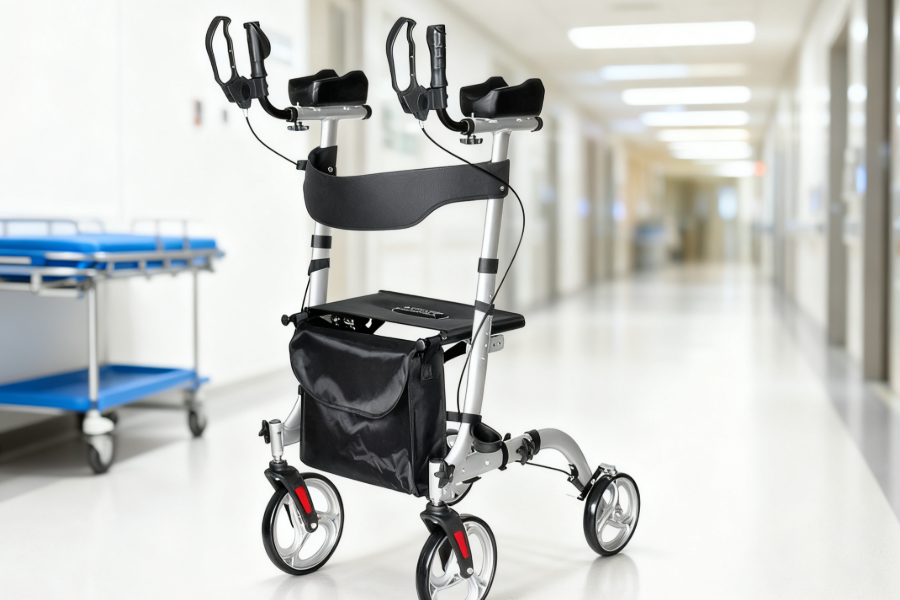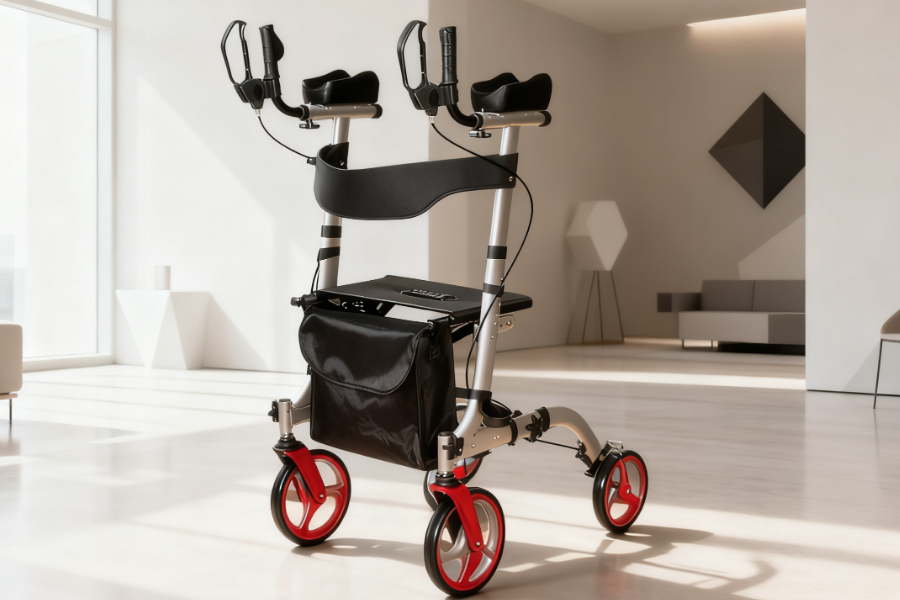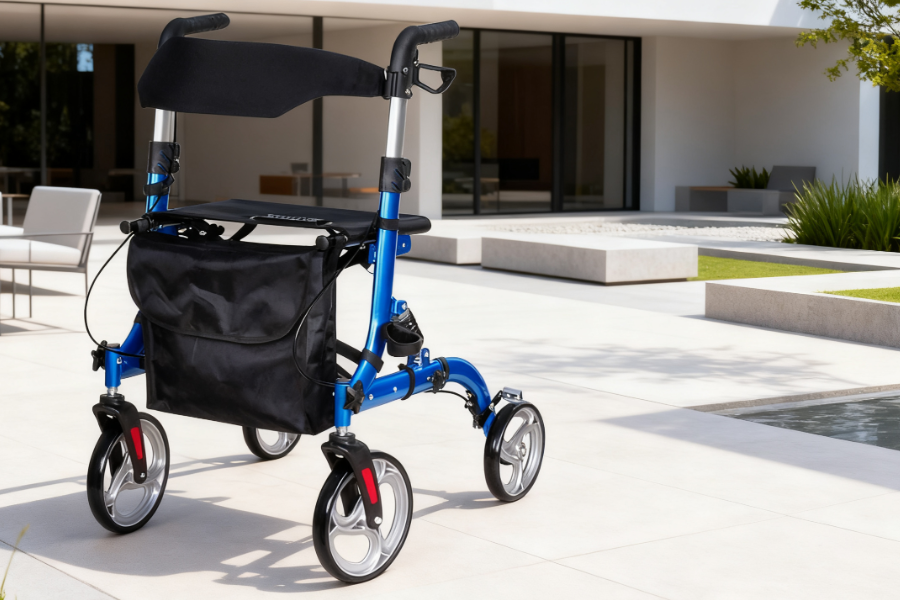The selection of a rollator requires more than basic mobility aid functionality because it represents a long-term commitment to independence and comfort. The durability of a rollator depends on three main elements which include its materials and design structure and how often it gets used and regular maintenance practices. Healthcare providers and distributors and rehabilitation specialists need to understand these factors because they determine the best combination of performance and affordability for their procurement decisions.

The operational lifespan of a rollator depends on its initial construction quality and the exactness of its components. The product features do not guarantee durability because actual usage conditions and proper maintenance practices play an equal role in determining lifespan.
The selection of materials determines how well a product will resist corrosion and how it will handle structural fatigue during its operational period. The selection of high-grade aluminum frames occurs because they provide light weight and natural rust resistance. The combination of reinforced welds with crossbars enhances the stability of the product when it experiences dynamic forces.
The Medical Aluminum Stand Up Rollator Walkers feature a thickened aluminum alloy frame which supports users who weigh up to 300 pounds (136 kg) to provide both safety and extended product life.

The durability of rollators depends on exact engineering of their components which include wheel bearings and braking systems and shock absorbers. The manufacturing quality of components determines how quickly they will deteriorate when users perform their activities at high speeds. The walker features a brake system with adjustable brake lever pressure that enables users to achieve complete immobilization while providing extended reliability. The shock-absorbing design helps distribute stress across wheels and joints.
The Lightweight Mobility Walking Aid Walkers Rollator provides users with better comfort and extended product life through its vibration reduction system. It is mainly designed to assist the elderly, people with mobility impairments, and the disabled in walking.

The mechanical stress levels of a rollator depend on whether it operates on smooth indoor floors or rough outdoor surfaces. The combination of water exposure with dirt particles and changing weight distribution leads to deterioration of wheel surfaces and joint components and braking systems. The product requires operation within its designated usage limits to maintain its structural soundness.
The evaluation process for rollator durability before buying requires organizations to review technical details and proof of standardized testing methods. The identification of essential features helps organizations prevent early equipment breakdowns.
The weight ratings need to match the expected weight range of users. A strong frame structure which supports heavy loads without deformation will provide extended service life. A wider wheelbase design enhances stability because it reduces the chances of tipping during turns and when driving on uneven surfaces. The reinforced aluminum alloy frame structure supports users who weigh up to 300 pounds (136 kg) to meet high-load performance requirements.
International safety and quality certifications including ISO 13485 and CE Marking should be your primary focus when making purchasing decisions. The standards enforce laboratory testing of product durability through simulated long-term usage. The full-cycle quality control system at Beiqin performs strict monitoring of raw materials and production steps and final product inspections to achieve better results than international requirements. The certification process verifies that the product underwent fatigue testing which mimics the performance of products used for multiple years in actual field conditions.
The manufacturer’s spare part availability together with technical assistance determines whether customers can perform maintenance on their products or need to replace them. Beiqin provides OEM/ODM customization with full service support globally which ensures your rollators will receive proper maintenance services after their initial deployment.
The design of frames serves more than visual purposes because it determines how the body will align during use and how forces will be distributed and how users will interact with the device. A well-designed system minimizes physical strain while creating a more comfortable user experience.
The ergonomic design of frames helps users maintain upright positions which minimizes muscle fatigue. The adjustable armrests on these devices serve two purposes: they fit users of various sizes and they adapt to changing requirements after an injury occurs. The upright walker with adjustable padded armrests maintains your natural upright position which benefits users who age or need rehabilitation because it is essential for their comfort.
A rollator designed for hospital and travel purposes needs to handle multiple folding operations during its service time. The locking system needs to stay precise in its operation throughout the entire usage period. The combination of strong alignment pins with compact folding mechanisms enables safe operation while maintaining user convenience.
The symmetrical design of the frame distributes weight evenly throughout the structure which protects individual components including rear wheels and axles from excessive stress. The position of the rear wheels determines how well the vehicle handles when navigating challenging terrain including ramps and gravel paths.
The selection of an OEM/ODM partner by distributors who need to handle different regional needs and create their own branded mobility solutions allows them to expand their operations while maintaining product excellence.
The different regions require their own specific ergonomic standards and branding requirements. Beiqin provides complete OEM/ODM solutions for worldwide markets through customized frame sizes and exclusive branding solutions.
The production process maintains batch consistency even when handling large volume orders. The factory at Beiqin operates international distribution through its automated production lines which work alongside its internal quality assurance teams.
The product development process at Beiqin follows end-user feedback which distributors collect from customers. The company operates spare part logistics to maintain continuous post-sale service delivery. The service portals at Beiqin provide continuous support to clients who receive updates about their products from start to finish.
Q1: What is the typical lifespan of a rollator device?
A: A rollator device which receives proper care and average use will operate for five to seven years.
Q2: What frame design provides the longest possible durability?
A: The best frame for long-term durability consists of thick aluminum alloy construction which provides both high strength and rust protection and light weight operation.
Q3: Can I replace parts like wheels or handles myself?
A: If the rollator is modular in design and compatible with OEM parts, components such as wheelsets or grips can be replaced easily without professional tools.
The selection of a rollator requires more than basic mobility aid functionality because it represents a long-term commitment to independence and comfort. The durability of a rollator depends on three main elements which include its materials and design structure and how often it gets used and regular maintenance practices. Healthcare providers and distributors and rehabilitation specialists need to understand these factors because they determine the best combination of performance and affordability for their procurement decisions.

The operational lifespan of a rollator depends on its initial construction quality and the exactness of its components. The product features do not guarantee durability because actual usage conditions and proper maintenance practices play an equal role in determining lifespan.
The selection of materials determines how well a product will resist corrosion and how it will handle structural fatigue during its operational period. The selection of high-grade aluminum frames occurs because they provide light weight and natural rust resistance. The combination of reinforced welds with crossbars enhances the stability of the product when it experiences dynamic forces.
The Medical Aluminum Stand Up Rollator Walkers feature a thickened aluminum alloy frame which supports users who weigh up to 300 pounds (136 kg) to provide both safety and extended product life.

The durability of rollators depends on exact engineering of their components which include wheel bearings and braking systems and shock absorbers. The manufacturing quality of components determines how quickly they will deteriorate when users perform their activities at high speeds. The walker features a brake system with adjustable brake lever pressure that enables users to achieve complete immobilization while providing extended reliability. The shock-absorbing design helps distribute stress across wheels and joints.
The Lightweight Mobility Walking Aid Walkers Rollator provides users with better comfort and extended product life through its vibration reduction system. It is mainly designed to assist the elderly, people with mobility impairments, and the disabled in walking.

The mechanical stress levels of a rollator depend on whether it operates on smooth indoor floors or rough outdoor surfaces. The combination of water exposure with dirt particles and changing weight distribution leads to deterioration of wheel surfaces and joint components and braking systems. The product requires operation within its designated usage limits to maintain its structural soundness.
The evaluation process for rollator durability before buying requires organizations to review technical details and proof of standardized testing methods. The identification of essential features helps organizations prevent early equipment breakdowns.
The weight ratings need to match the expected weight range of users. A strong frame structure which supports heavy loads without deformation will provide extended service life. A wider wheelbase design enhances stability because it reduces the chances of tipping during turns and when driving on uneven surfaces. The reinforced aluminum alloy frame structure supports users who weigh up to 300 pounds (136 kg) to meet high-load performance requirements.
International safety and quality certifications including ISO 13485 and CE Marking should be your primary focus when making purchasing decisions. The standards enforce laboratory testing of product durability through simulated long-term usage. The full-cycle quality control system at Beiqin performs strict monitoring of raw materials and production steps and final product inspections to achieve better results than international requirements. The certification process verifies that the product underwent fatigue testing which mimics the performance of products used for multiple years in actual field conditions.
The manufacturer’s spare part availability together with technical assistance determines whether customers can perform maintenance on their products or need to replace them. Beiqin provides OEM/ODM customization with full service support globally which ensures your rollators will receive proper maintenance services after their initial deployment.
The design of frames serves more than visual purposes because it determines how the body will align during use and how forces will be distributed and how users will interact with the device. A well-designed system minimizes physical strain while creating a more comfortable user experience.
The ergonomic design of frames helps users maintain upright positions which minimizes muscle fatigue. The adjustable armrests on these devices serve two purposes: they fit users of various sizes and they adapt to changing requirements after an injury occurs. The upright walker with adjustable padded armrests maintains your natural upright position which benefits users who age or need rehabilitation because it is essential for their comfort.
A rollator designed for hospital and travel purposes needs to handle multiple folding operations during its service time. The locking system needs to stay precise in its operation throughout the entire usage period. The combination of strong alignment pins with compact folding mechanisms enables safe operation while maintaining user convenience.
The symmetrical design of the frame distributes weight evenly throughout the structure which protects individual components including rear wheels and axles from excessive stress. The position of the rear wheels determines how well the vehicle handles when navigating challenging terrain including ramps and gravel paths.
The selection of an OEM/ODM partner by distributors who need to handle different regional needs and create their own branded mobility solutions allows them to expand their operations while maintaining product excellence.
The different regions require their own specific ergonomic standards and branding requirements. Beiqin provides complete OEM/ODM solutions for worldwide markets through customized frame sizes and exclusive branding solutions.
The production process maintains batch consistency even when handling large volume orders. The factory at Beiqin operates international distribution through its automated production lines which work alongside its internal quality assurance teams.
The product development process at Beiqin follows end-user feedback which distributors collect from customers. The company operates spare part logistics to maintain continuous post-sale service delivery. The service portals at Beiqin provide continuous support to clients who receive updates about their products from start to finish.
Q1: What is the typical lifespan of a rollator device?
A: A rollator device which receives proper care and average use will operate for five to seven years.
Q2: What frame design provides the longest possible durability?
A: The best frame for long-term durability consists of thick aluminum alloy construction which provides both high strength and rust protection and light weight operation.
Q3: Can I replace parts like wheels or handles myself?
A: If the rollator is modular in design and compatible with OEM parts, components such as wheelsets or grips can be replaced easily without professional tools.
Share To:
related articles
You can contact us any way that ls convenient for you.